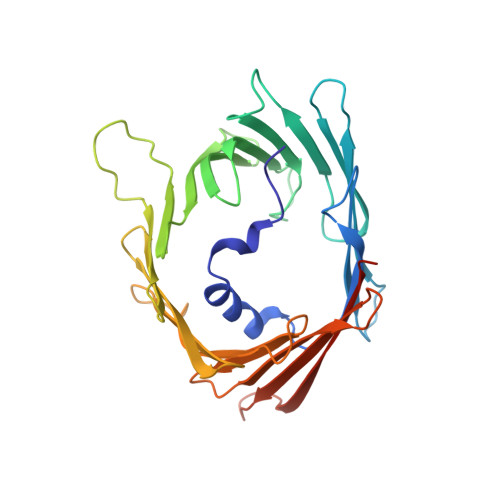Structure and Gating Behavior of the Human Integral Membrane Protein VDAC1 in a Lipid Bilayer.
Najbauer, E.E., Tekwani Movellan, K., Giller, K., Benz, R., Becker, S., Griesinger, C., Andreas, L.B.(2022) J Am Chem Soc 144: 2953-2967
- PubMed: 35164499
- DOI: https://doi.org/10.1021/jacs.1c09848
- Primary Citation of Related Structures:
7QI2 - PubMed Abstract:
The voltage-dependent anion channel (VDAC), the most abundant protein in the outer mitochondrial membrane, is responsible for the transport of all ions and metabolites into and out of mitochondria. Larger than any of the β-barrel structures determined to date by magic-angle spinning (MAS) NMR, but smaller than the size limit of cryo-electron microscopy (cryo-EM), VDAC1's 31 kDa size has long been a bottleneck in determining its structure in a near-native lipid bilayer environment. Using a single two-dimensional (2D) crystalline sample of human VDAC1 in lipids, we applied proton-detected fast magic-angle spinning NMR spectroscopy to determine the arrangement of β strands. Combining these data with long-range restraints from a spin-labeled sample, chemical shift-based secondary structure prediction, and previous MAS NMR and atomic force microscopy (AFM) data, we determined the channel's structure at a 2.2 Å root-mean-square deviation (RMSD). The structure, a 19-stranded β-barrel, with an N-terminal α-helix in the pore is in agreement with previous data in detergent, which was questioned due to the potential for the detergent to perturb the protein's functional structure. Using a quintuple mutant implementing the channel's closed state, we found that dynamics are a key element in the protein's gating behavior, as channel closure leads to the destabilization of not only the C-terminal barrel residues but also the α2 helix. We showed that cholesterol, previously shown to reduce the frequency of channel closure, stabilizes the barrel relative to the N-terminal helix. Furthermore, we observed channel closure through steric blockage by a drug shown to selectively bind to the channel, the Bcl2-antisense oligonucleotide G3139.
- Department of NMR-Based Structural Biology, Max Planck Institute for Multidisciplinary Sciences, Am Faßberg 11, 37077 Göttingen, Germany.
Organizational Affiliation:
















